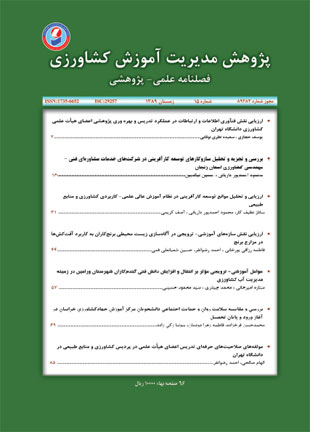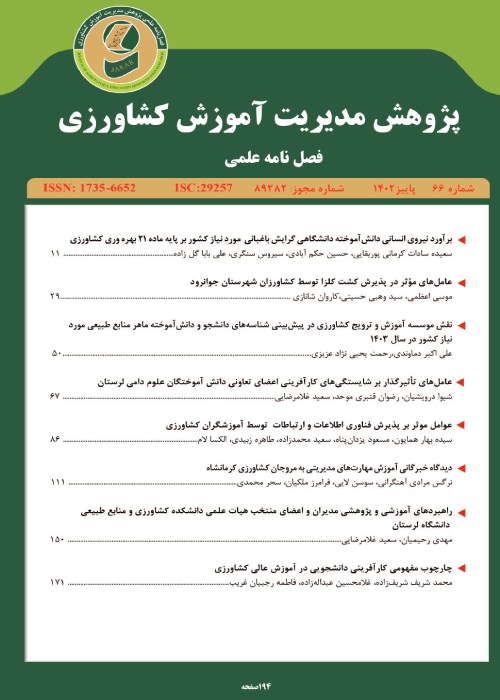فهرست مطالب

نشریه پژوهش مدیریت آموزش کشاورزی
سال دوم شماره 15 (زمستان 1389)
- تاریخ انتشار: 1389/11/19
- تعداد عناوین: 7
-
-
Page 2
Regarding the complexity of academic careers, the high volume of information and itsincreasing expansion, providing faculty members with necessary facilities is inevitable.Nowadays, information and communication technology (ICT) is considered to be a partof educational technology in academic system. The main objective of this study is toinvestigate the role of ICT in teaching performance and research productivity of facultymembers in agriculture field of study in university of Tehran. The statistical populationof the study consisted of all 250 faculty members. Reliability of the questionnaire wasconfirmed by computing Cronbach’s alpha coefficient (0.08). Research results showedthat there is a significant positive relationship between the level of knowledge, skill andattitude of the faculty members regarding ICT and its usage. The regression analysisalso revealed that filling out online submission forms and internet websites familiarityhad highest effect on the usage of ICT among the faculty members. According toregression procedure, about 27% of variation concerning teaching performance andresearch productivity can be explained by the usage of relevant websites and software.
-
Page 16This descriptive survey was carried out to investigate the mechanism of offering agriculture technical and engineering advice in Zanjan province. The statistical population of the study consisted of 358 corporations, out of which 95 were selected as the sample using proportional stratified sampling technique. The validity of the questionnaire was approved by a panel of experts. Also, to measure the reliability the questionnaire, Cronbach’s alpha coefficients for the main scales were estimated to be estimated to be 0.82 & 0.92. According to the results, two issues including “financial support offered by the government” as well as “holding training courses concerning entrepreneurial skills” turned out have the highest priority to deal with, in entrepreneurship development in above-mentioned corporations. To identify the components of such mechanism in the corporation, an exploratory factor analysis method was employed. In addition, confirmatory factor analysis method as well as structural equations model were used to investigate the index surpasses model. Finally, it appeared that six distinctive components including educational, supportive, communicative, management, skill and policy-making ones account for the mechanism of entrepreneurship development in advisory service corporations.Keywords: Mechanism, Entrepreneurship, Advisory services corporations
-
Page 31The main objective of this descriptive survey research was to analyze the barriers to entrepreneurial development in applied science agricultural and natural resources higher education system in Iran. The statistical population of the study consisted of some graduates of educational institutions offering applied science agricultural and natural resources courses, out of which, some 319 were selected as the sample using Cochran formula and multi steps sampling technique. The data were gathered by a questionnaire devised for the study and were analyzed by SPSS-win and LISREL software. The validity of the questionnaire was approved by a panel of experts and its reliability was estimated to be 0.91 using Cronbach’s alpha coefficient. Prioritizing the barriers to entrepreneurial development, two most important ones appeared to be lack of attention to entrepreneurial skills in developing the curricula and syllabuses as well as lack of sufficient attention to practical education based on market oriented necessities. To identify the components of these barriers, discovery factor analysis was employed. In addition, confirmation factor analysis and structural equations models were used to investigate the index surpasses model. According to the results, four distinctive issues including educational, infrastructural-supportive, policy-making as well as individualpsychological factors turned out to the main barriers to entrepreneurial development in applied science agricultural and natural resources higher education system.
-
Page 44This study was implemented to investigate the role of educational-extension factors on the environmental awareness of pesticide use among paddy farmers in Sari rural area. The study is an applied survey and the statistical population consisted of 28170 farmers residing in five districts. Using stratified proportional random sampling, 260 ones were selected as the sample by Cochran formula. Data were collected by a questionnaire, which its validity was obtained by a group of experts working in Jihad-e-agriculture ministry as well as a panel of faculty members of agricultural extension and education dept., university of Tehran. To measure reliability of the questionnaire, Coronbach’s Alpha formula was calculated. It turned out that there is a significant, positive correlation between some qualities of farmers such as background in acquaintance with extension service, participation in extension-education courses, FFS programs, number of extension contacts, rate of participation in extension-education workshops, study of extension publications with environmental awareness of pesticide use among paddy farmers. The results revealed that paddy farmers who participated in extensioneducation courses, FFS programs and demonstration fields, had higher level environmental awareness of pesticide use compared with those who did not attended such practices.Keywords: environmental awareness, educational, extension factors, FFS, rice pesticide
-
Page 57This study was carried out to identify the most important educational-extension factors influencing on vocational know-how of wheat farmers in Varamin city concerning agriculture water management. In the study, a descriptive-correlational method was employed, in which some 334 out of 2484 farmers were selected as the sample using proportional stratified sampling system. A questionnaire as well as interview, whose validity had been confirmed by a panel of academic staff, was employed to gather the required data. Also, the reliability was estimated to be 0.88 by Cronbach’s alpha. According to the results, the technical know-how level of farmers appeared to have positive significant correlation with some research variables, such as extension practitioners and farmers gathering in rural areas, attending extension-educational courses and workshops, holding some field trips visiting irrigation systems and tillage equipment and finally, watching relevant TV programs. In addition, the results from stepwise regression also indicated that 41% of variation in the level of technical know-how of farmers can be explained by the variables including attending the extension-educational courses and workshops, watching relevant TV programs, extension practitioners and farmers gathering in the field, performance of wheat farming as well as extension practitioners and farmers gathering in the villages.Keywords: educational, extension factors, professional know, how, optimal water management, wheat farmers
-
Page 69According to the WHO, providing people with health and pursuing its promotion in the society is a significant duty of governments. Confronting numerous challenges and crisis in the most sensitive growth period of age, students are likely to be mentally or emotionally hurt in the educational environment. Therefore, obtaining mental health for the students plays a pivotal role in educational process. This comparative study was carried out to investigate the rate of psychological health and social sympathy for the students in Khorasan Razavi Jehad-e- Agriculture Higher Educational Institution, at the time of entrance and graduation. The statistical population consisted of some 437 graduates who entered the institution in 20 and graduated in 2009. A descriptive-cross-sectional method was employed to implement the study and the data were gathered using a General Health Questionnaire (GHQ) containing some items regarding general health and social sympathy. Data were statistically described and then analyzed using correlation of variables through determining correlation coefficient, independent t. Test as well as factor analysis. The results indicated that psychological health of students at the time of graduation significantly improved compared to the time of entrance (p 0.01). In addition, assuming equal variance of students at the time of entrance, some factors such as gender, marital status and acceptance quota significantly affected psychological health condition. In this regard, male, married and employed students enjoyed better psychological health condition compared to female, unmarried and unemployed respectively. However, it was not affected by the factors at the time of graduation. It also turned out that there was a significant positive correlation between and social sympathy for students.Keywords: psychological health, social sympathy, entrance, graduation, scientificapplied higher education students
-
Page 85This survey was conducted to investigate professional teaching competencies in higher education used by the academic staff of the College of Agriculture and Natural Resources, University of Tehran. Some 157 members of the academic staff who were involved in teaching in 2008-2009 were included as the statistical population, from which 60 were selected as the research sample through simple-randomization method using Qukrun formula. Then, a questionnaire was designed and employed to gather the required data. The validity of the questionnaire was confirmed by a panel of the academic staff of the department of agriculture extension education, College of Agriculture and Natural Resources, university of Tehran and its reliability was depicted by Cranach’s alpha. The results indicated that from 25 teaching competency-related parameters, two including familiarization with students’ disposition as well as informing students about their educational improvement had first and second priorities. In addition, it turned out that four factors including education, evaluation, management, and communication explained about 75.45% of variations in the components of professional teaching competency in agriculture higher education.Keywords: professional teaching competency, higher education, faculty members


